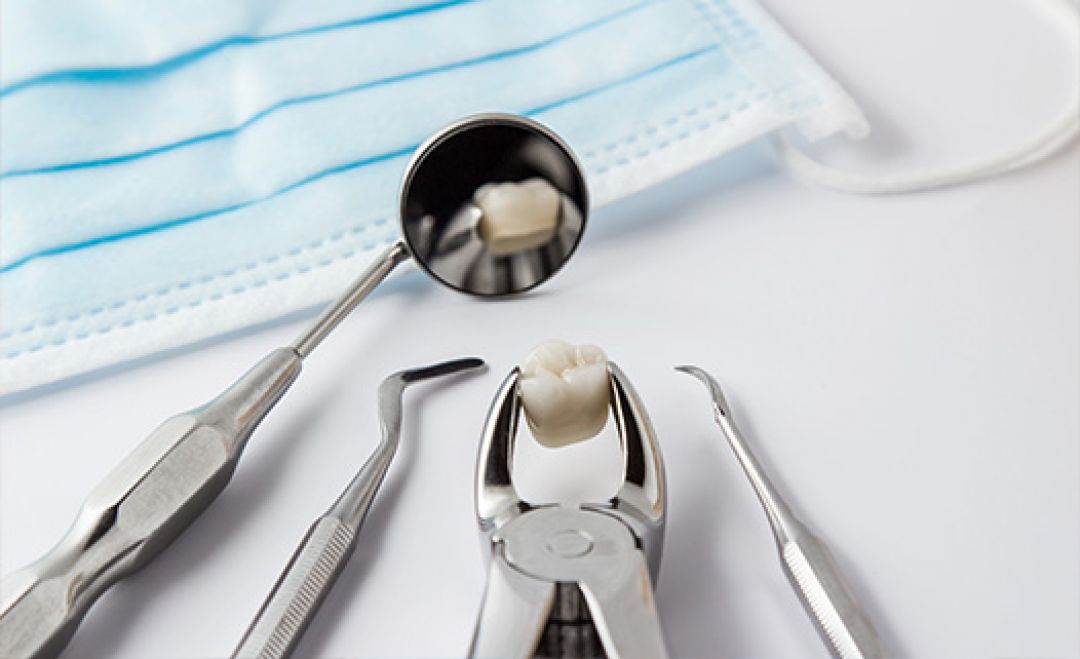Tooth Extraction
Avarage Time Needed
Anesthesia Type
Average Session Required
Recovery Time

Online Consultation
What Is Tooth Extraction and When Is It Necessary?
Tooth extraction is a dental procedure where a tooth is removed from its socket in the bone. Dentists perform extractions when a tooth is damaged, decayed, or causing pain. This procedure can be simple or surgical, depending on the tooth’s position and condition. Simple extractions are done on teeth that are easily accessible. Surgical extractions require more care and are used for teeth that are broken or impacted. Both methods involve numbing the area with anesthesia to ensure a painless experience.
Extractions become necessary for several reasons. Severe decay may damage a tooth beyond repair. Infections that spread to the bone or surrounding tissues can also lead to extraction. Crowding in the mouth might force a dentist to remove a tooth to allow space for others. Impacted wisdom teeth, which do not fully emerge, often cause pain and infection, making extraction the best option. Additionally, gum disease can weaken the tooth’s structure, increasing the risk of tooth loss. In cases where a tooth is fractured or damaged due to trauma, an extraction may prevent further complications.
Patients should consult their dentist to explore alternatives before deciding on extraction. Dentists consider a patient’s overall dental health, the location of the tooth, and the cause of the problem. After the extraction, proper care is essential to avoid infection and ensure smooth healing. Following a dentist’s advice on diet, oral hygiene, and medication can help patients recover quickly and maintain good oral health.
How Should You Prepare for a Tooth Extraction Procedure? (H2)
Proper preparation for a tooth extraction can ensure a smooth and comfortable experience:
- Consultation: Schedule a consultation with your dentist to discuss the reasons for extraction and explore alternatives.
- Medical History: Inform your dentist about your medical history, including any medications or allergies.
- Arrangements: Arrange for someone to drive you home if sedation is required.
- Fasting: If sedation is planned, you may need to fast for a certain period before the procedure.
- Oral Hygiene: Maintain good oral hygiene leading up to the extraction to reduce the risk of infection.
What Are the Different Types of Tooth Extractions?
Tooth extractions can be classified into two main types which are simple extraction and surgical extraction.
Simple Extraction
A simple extraction involves removing a tooth that is visible in the mouth. The procedure is usually straightforward and can be performed under local anesthesia.
Surgical Extraction
Surgical extractions are more complex and are required for teeth that are not easily accessible, such as impacted wisdom teeth. This type may involve cutting the gum and removing bone to access the tooth.
What Can You Expect During the Tooth Extraction Process?
Understanding the extraction process can alleviate anxiety.
- Anesthesia: Local anesthesia is applied to numb the area around the tooth. In some cases, sedation may be used.
- Loosening the Tooth: The dentist uses special tools to loosen the tooth from the jaw.
- Removal: The tooth is carefully removed from the jaw.
- Post-Extraction Care: Gauze may be placed to control bleeding and aftercare instructions are given.
Is Tooth Extraction Painful?
Tooth extraction is generally not painful due to the use of anesthesia. However, some discomfort and pain is normal during the healing process. Over-the-counter pain relievers or prescription medications can help you manage post-extraction pain.
What Are the Risks and Complications Associated with Tooth Extractions? (H2)
While tooth extractions are routine, there are potential risks and complications, including:
- Infection: Bacteria entering the extraction site may cause infection.
- Dry Socket: If a blood clot does not form or is dislodged, bone and nerves are exposed.
- Nerve Damage: Rarely, nerves in the extraction site may be damaged.
- Excessive Bleeding: Prolonged bleeding may occur and may require additional treatment.
How Should You Care for Your Mouth After a Tooth Extraction?
Proper aftercare is crucial for healing and preventing complications:
- Rest: Rest for the first 24 hours.
- Ice Packs: Apply ice packs to reduce swelling.
- Gauze: Use gauze to control bleeding.
- Oral Hygiene: After the first 24 hours, gently rinse your mouth with salt water, avoiding the extraction site.
- Avoid Straws: Do not use a straw to prevent dislodging a blood clot.
What Is Dry Socket and How Can It Be Prevented?
Dry socket is a painful condition that can occur after a tooth extraction. Normally, a blood clot forms in the empty socket to protect the bone and nerves and to promote healing. In dry socket, this clot is dislodged or dissolves before the wound has healed. Without this protective layer, the underlying bone and tissues become exposed, leading to intense pain and a delayed healing process.
The condition is most common after the removal of wisdom teeth, but it can happen with any extraction. Patients with dry socket often experience severe, throbbing pain that radiates from the extraction site to the ear, eye, or neck on the same side of the face. Other symptoms include a foul taste or odor in the mouth and visible bone in the socket.
Preventing dry socket starts with following your dentist’s or oral surgeon’s post-operative care instructions closely. One of the most important measures is avoiding actions that can disturb the blood clot. Patients should refrain from smoking, as the chemicals in cigarettes can delay healing and weaken the clot. Sipping through a straw, vigorous rinsing, or spitting excessively should also be avoided, especially during the first few days after extraction.
Maintaining good oral hygiene is crucial. Gently rinsing with a saltwater solution as directed can help reduce the risk of infection without disrupting the clot. Keeping follow-up appointments with your dental professional ensures that any early signs of complications are addressed promptly, leading to a smoother and quicker recovery.
When Can You Resume Normal Activities After a Tooth Extraction?
Most people can return to their normal activities the day after the extraction. However, it is important to:
- Avoid Strenuous Activities: Avoid heavy lifting or intense exercise for several days.
- Monitor Healing: Listen to your body and rest if you experience significant discomfort.
What Are the Options for Replacing an Extracted Tooth?
Replacing an extracted tooth helps maintain oral function and aesthetics. Options include:
- Dental Implants: Titanium posts that act as tooth roots, supporting crowns.
- Bridges: Artificial teeth that are anchored to adjacent natural teeth.
- Dentures: Removable appliances that replace multiple missing teeth.
How Does Tooth Extraction Impact Overall Oral Health?
Tooth extraction can have several impacts on oral health:
- Alignment: Neighboring teeth may shift, affecting bite and alignment.
- Bone Density: There may be a loss of bone density in the jaw where the tooth was extracted over time.
- Functionality: Missing teeth can affect chewing and speaking functions.
Maintaining good oral hygiene and considering tooth replacement options can mitigate these effects.
Are There Alternatives to Tooth Extraction?
In some cases, alternatives to tooth extraction may be possible, such as:
- Root Canal Therapy: Saving the tooth by removing the infected pulp.
- Crowns or Fillings: Repairing a damaged tooth to avoid extraction.
- Orthodontic Treatment: Realigning teeth to correct overcrowding or bite problems.
Consult your dentist to evaluate the option best suited to your situation.
How Much Does a Tooth Extraction Cost?
At Denthub, tooth extraction costs depend on the complexity of the procedure. A simple tooth extraction is priced at £30, while a complicated tooth extraction costs £60. These differences reflect the level of difficulty involved in removing the tooth. For example, a tooth that is already loose or easily accessible may require less time and effort, leading to a lower price. On the other hand, if a tooth is broken below the gumline or has curved roots, it might be classified as complicated, which increases the procedure’s cost.
When it comes to wisdom teeth, the prices can also vary. Denthub charges £80 for a simple wisdom tooth surgery and £130 for a complicated wisdom tooth surgery. Simple procedures may involve extracting wisdom teeth that have fully erupted, whereas more complex surgeries often deal with impacted teeth that lie partially or completely below the gum tissue.
These extraction costs usually include the basic services needed for a safe removal, such as local anesthesia. Additional charges may apply if you require sedation, special aftercare products, or follow-up treatments. It is best to discuss your individual case with a Denthub professional beforehand to get a clear idea of the total expected cost.
How Do You Know If You Need a Tooth Extraction?
Signs that you may need a tooth extraction include:
- Severe Decay: When a tooth cannot be restored with a filling or crown.
- Infection: When an uncontrolled infection that does not respond to antibiotics.
- Crowding: When excessive teeth cause alignment problems.
- Impaction: Wisdom teeth that have become trapped around the tooth.
Consult a dental professional to evaluate your condition and recommend appropriate treatment.
What Should You Eat After a Tooth Extraction?
Eating the right foods after a tooth extraction can promote healing and reduce discomfort. Good choices include:
- Soft Foods: Yogurt, pureed potatoes, smoothies, and soups.
- Protein-Rich Foods: Scrambled eggs and soft tofu.
- Avoid Hard or Chewy Foods: These foods can irritate the extraction site.
50 soft foods to eat after tooth extraction:
- Applesauce
- Broth-based soups
- Mashed bananas
- Scrambled eggs
- Smoothies (without seeds)
- Yogurt
- Pudding
- Cottage cheese
- Oatmeal
- Creamed vegetables
- Mashed potatoes
- Pureed soups
- Soft pasta
- Rice pudding
- Avocado
- Hummus
- Soft-cooked oatmeal
- Polenta
- Ice cream (without chunks)
- Soft fish
- Tofu
- Soft-cooked beans
- Soft cheeses
- Jell-O
- Soft bread soaked in soup
- Soft pancakes
- Soft muffins
- Soft cereals with milk
- Smooth nut butters
- Soft turkey or chicken (minced)
- Gelato
- Custard
- Soft-cooked vegetables
- Egg salad (without crunchy additions)
- Soft tofu scramble
- Baked apples (softened)
- Soft, ripe pears
- Soft-cooked grains like quinoa
Online Consultation






